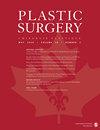流行病学、诊断、治疗和整形手术结果中的健康不平等:范围综述
IF 0.6
4区 医学
Q Medicine
引用次数: 0
摘要
背景:整形手术是治疗乳腺癌、唇腭裂和性别确认护理的常规方法。整形手术在流行病学、诊断、治疗和患者经历的结果方面存在不公平。我们的范围综述的目的是:(1)概述当前关于整形手术中健康不平等的文献,(2)提请注意这些文献中的空白。方法:本范围审查是根据乔安娜布里格斯研究所和PRISMA扩展范围审查的指导方针制定的。对MEDLINE(通过PubMed)、Ovid Embase、Cochrane系统评价数据库和Scopus数据库进行了初步搜索,以定位已发表的关于整形外科健康不平等的文章。文章必须涉及我们研究过的美国国立卫生研究院(National Institutes of Health)不平等群体中的至少一个。结果:在审查全文后,153项研究被纳入我们的最终样本。我们发现种族/民族(94/153)和年龄(90/153)是范围评估中最常评估的两个不公平因素。我们发现,年龄较大或没有公共保险和/或历史上处于边缘的种族/民族群体的患者通常不太可能接受整形手术治疗。结论:这篇范围综述描述了目前关于整形手术中健康不平等的文献,并强调了文献中值得进一步研究的空白。我们发现了关于弱势患者群体如何受到卫生不平等影响的重要发现。应开展研究,更彻底地调查这些不平等现象,并找出最佳解决办法,弥合在提供公平护理方面的差距。本文章由计算机程序翻译,如有差异,请以英文原文为准。
Health Inequities in the Epidemiology, Diagnosis, Treatment, and Outcomes of Plastic Surgery: A Scoping Review
Background: Plastic surgery is routinely sought after for the treatment of breast cancer, cleft lip and palate, and gender-affirming care. Inequities exist in plastic surgery in regard to the epidemiology, diagnosis, treatment, and outcomes experienced by patients. The purpose of our scoping review was to (1) outline current literature addressing health inequities in plastic surgery and (2) draw attention to the gaps in this literature. Methods: This scoping review was developed following guidelines from the Joanna Briggs Institute and PRISMA extension for scoping reviews. An initial search of MEDLINE (via PubMed), Ovid Embase, Cochrane Database of Systematic Reviews, and Scopus databases was performed to locate published articles on health inequities in plastic surgery. Articles had to address at least one of the National Institutes of Health's inequity groups we examined. Results: After reviewing full text, 153 studies were included in our final sample. We found race/ethnicity (94/153) and age (90/153) to be the 2 most commonly evaluated inequities in the scoping review. We discovered that patient populations that were older had public or no insurance and/or were in historically marginalized racial/ethnic groups were often less likely to be offered plastic surgery treatments. Conclusion: This scoping review describes the current literature on health inequities in plastic surgery and highlights gaps in the literature that warrant further research. We found significant findings regarding how vulnerable patient populations are affected by health inequities. Research should be conducted to investigate these inequities more thoroughly and discover the best solutions to bridge the gaps in providing equitable care.
求助全文
通过发布文献求助,成功后即可免费获取论文全文。
去求助
来源期刊

Plastic Surgery
SURGERY-
CiteScore
0.67
自引率
0.00%
发文量
0
审稿时长
6-12 weeks
期刊介绍:
Plastic Surgery (Chirurgie Plastique) is the official journal of the Canadian Society of Plastic Surgeons, the Canadian Society for Aesthetic Plastic Surgery, Group for the Advancement of Microsurgery, and the Canadian Society for Surgery of the Hand. It serves as a major venue for Canadian research, society guidelines, and continuing medical education.
 求助内容:
求助内容: 应助结果提醒方式:
应助结果提醒方式:


